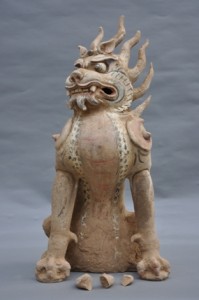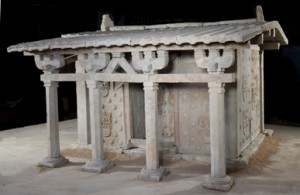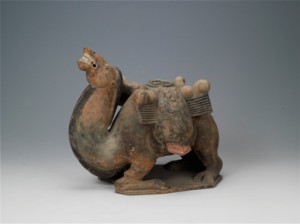by Seth Rogovoy
(WILLIAMSTOWN, Mass.) – Archeology. Northern Chinese art. Medieval Chinese history. None of these are things in which, at least on paper, I am remotely interested. And if a trio of exhibitions concerning Northern Chinese archeological discoveries of items from about 1,500 years ago weren’t at the Sterling and Francine Clark Art Institute, I very likely – no, certainly – would never have bothered to view them.
Which is all the more reason why you should listen to me when I say go see The Clark’s trio of exhibitions of Northern Chinese archeological finds. Because the material in the exhibitions are remarkable, stunning, and beautiful – significant and great human achievements, no less — and the stories surrounding their origins and discoveries are equally fascinating.
And the fact that this is all taking place at The Clark, rather than the Metropolitan Museum of Art or some other major urban center — and that these objects will only be on display at The Clark, where they are being seen by the public for the very first and perhaps only time, before returning to China — is all the more reason to go.
But of course it had to be The Clark, as the story behind the exhibitions inextricably intertwines with Sterling Clark himself, who among other things, was an explorer, and specifically an explorer of Northern China.
While Clark himself didn’t uncover the major finds in Unearthed: Recent Archaeological Discoveries from Northern China – those are of more recent vintage – it was the story of Clark’s Chinese expeditions that put all this in motion. The documentation of his trip, including photographs and natural science specimens, that Clark returned with have proven uniquely valuable to Chinese historians, and his work has been the subject of exhibitions back in China.
In exchange, museumgoers at The Clark are being given the singular opportunity to view this unique collection of burial figurines that were uncovered in 2004 when the area was being developed for a university.
These are the kinds of shows – small, precise, beautiful, with a scholarly component, devoid of hype, with an element of connoisseurship, and expensive – that The Clark does so well, indeed, that only The Clark can do, in many cases. On paper it may not be sexy, but its impact is striking and the installation unsurpassed anywhere. There is plenty of wow factor here, the ostensible subject notwithstanding.
The exhibitions are part of The Clark’s current cultural exchange initiative with China, and were inspired by a scientific expedition to Northern China undertaken by Sterling Clark in 1908 to document the region’s terrain, ecology, and meteorological conditions. In 2008, The Clark initiated a series of cultural exchange programs through China’s Ministry of Culture to connect Sterling Clark’s pioneering work in China with contemporary audiences. It is through these efforts that special permission was granted to allow these rare archaeological objects to travel to America for exhibition at The Clark.
The 2012 exhibitions also commemorate the 100th anniversary of the publication of Through Shên-kan: The Account of the Clark Expedition in North China, 1908–9, written by Sterling Clark and naturalist Arthur deCarle Sowerby to document the events and findings recorded by their expeditionary team during the 17-month trek across the remote regions of Northern China.
Unearthed: Recent Archaeological Discoveries from Northern China boasts an impressive collection of objects, artifacts, and a 10-ton stone sarcophagus in the form of a traditional Chinese house, which measures nearly 8 ft. x 12 ft. Its installation at The Clark – to where it was transferred in over 100 separate stone pieces, many of them numbered not yesterday but by the masons who originally built the burial house 1,600 years ago, is the first time in which the burial house will be fully assembled since being removed from the Shanxi province excavation site in 2004.
Several earthenware burial figures of animals and people removed from the same tomb are included in the exhibition. Having been freshly buried shortly after they were created and then untouched for the last millennium and a half, these intricately carved beautiful items – representatives of soldiers and animals — are incredibly well preserved, with seemingly little to no structural damage or other wear and tear. The paint colors are nearly as bright as the day the paint was applied (unless I misunderstood and there was restoration done to them; I am looking into that).
Six objects in the exhibition come from a tomb discovered in 2009 in Gansu province. Included among these is a group of magnificent polychrome terra cotta tomb guardians—some measuring more than 4 feet high—that are displayed exactly as they were positioned when placed in the tomb in the eighth century. Other ornamental artifacts in the exhibition, including a Buddhist stele and reliquary, reflect the cultural diversity of China’s Silk Road.
Companion exhibitions include Through Shên-Kan: Sterling Clark in China and Then & Now: Photographs of Northern China. Both are presented in the galleries of the Stone Hill Center; the former tells the story of the 1908-9 expedition that provided the impetus for the Clark’s current collaboration with Chinese cultural institutions, the latter presents a series of contemporary images taken by Chinese photographer Li Ju juxtaposed with the same scenes as photographed during the Clark expedition.
You will have to travel to New York City to see a fourth companion exhibition – Phantoms of the Clark Expedition, an installation by Mark Dion, which views Sterling Clark’s original expedition to China with a distinctly contemporary eye. Curated by Lisa G. Corrin, Director of Northwestern University’s Mary and Leigh Block Museum of Art, the new work by Dion consists of dioramas and sculptures of “specimens” relating to and inspired by the 1908 expedition, as well as tools and materials that would have been used on scientific explorations of the period.
Inspired by early installations in museums of natural history, most objects in the installation are fabricated of papier-mâché and left unpainted so that Dion’s specimens reflect the “bones” of a past era. Among the artifacts is a life-size model of a boar similar to one that was captured on the Clark expedition, an oversized squirrel and moth, and evocative dioramas of campfires and expeditionary implements.
The Clark’s selection of The Explorers Club as the site of the installation underscores the Club’s connections both to the history of exploration and to the Clark family. The Explorers Club is housed in a townhouse at 46 East 70th Street that was originally commissioned in 1911 by Sterling Clark’s brother Stephen as a wedding gift for his bride. Sterling (then resident in Paris) and Stephen maintained a lively correspondence during the construction process as the brothers consulted on many of the architectural elements incorporated in the house. Stephen Clark used the house’s large fifth-floor room (that today serves as The Explorers Club’s Trophy Room) to display works from his modern art collection. Today, The Explorers Club building is also the home of the Clark’s New York office.



